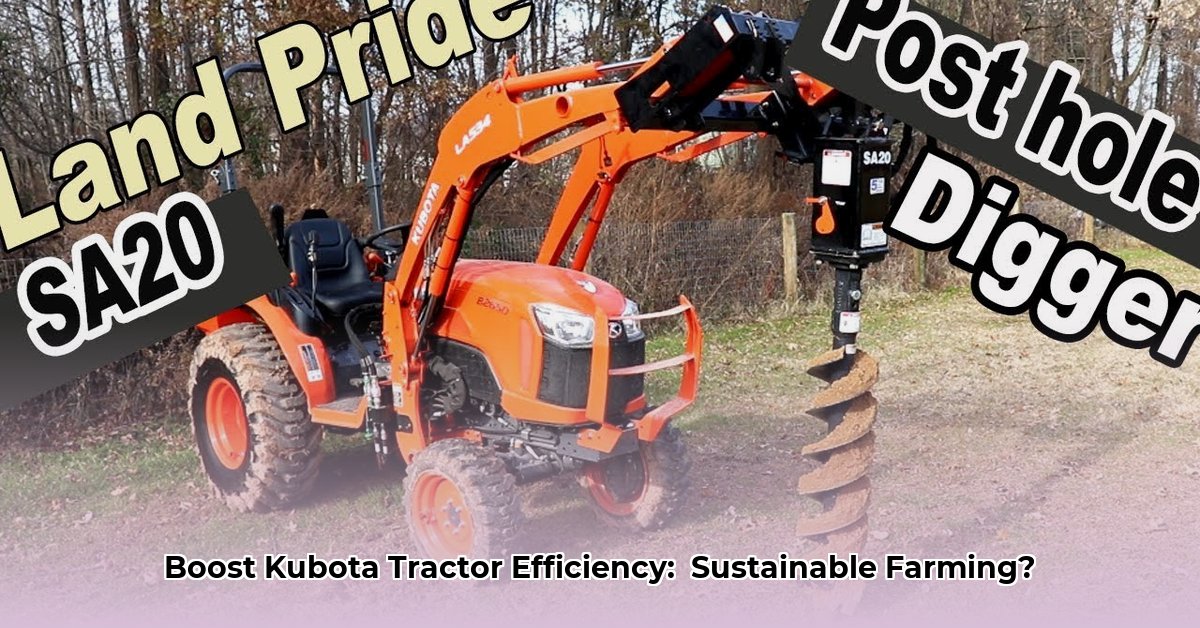
Auger Attachments for Your Kubota: Digging Deeper into Efficiency and Sustainability
Farming demands efficiency and sustainability. A post-hole digger auger attachment for your Kubota tractor significantly improves both. This guide provides practical steps to select, use, and maintain auger attachments, maximizing your Kubota's potential while minimizing your environmental impact. We'll explore various auger types, delve into maintenance best practices, and highlight their versatility beyond just post-hole digging. For more Kubota information, check out the Kubota manual. Are you ready to boost your farm's productivity and sustainability?
Picking the Perfect Post-Hole Digger for Your Kubota
Selecting the right auger attachment is crucial. Consider these factors:
- Hole Size: What diameter holes are needed? (e.g., 6 inches for fence posts, 12 inches for trees). The auger bit's diameter must match your needs.
- Soil Type: Will you encounter clay, sandy loam, or rocky ground? Different augers are designed for various soil conditions. Rock augers tackle tough terrain while earth augers are suitable for softer soils.
- Kubota Compatibility: Ensure the auger's weight and power requirements are compatible with your tractor's capacity. Overloading your Kubota could lead to damage.
Here's a table summarizing key considerations:
| Feature | Considerations | Example |
|---|---|---|
| Auger Diameter (Inches) | Match diameter to post or intended use | 6 inches (fence posts), 12 inches (trees) |
| Auger Type | Earth auger (soft soil), rock auger (rocky soil), specialized augers (e.g., drainage) | Choose based on soil conditions |
| Power Source | PTO (Power Take-Off) driven – check your Kubota's manual for compatibility. | Verify compatibility with your Kubota's PTO |
| Hydraulics | Ensure your Kubota has sufficient hydraulic capacity. | Check your Kubota's specifications |
Beyond Fence Posts: Unlocking the Auger's Versatility
Post-hole diggers offer more than just fence installation. They significantly contribute to sustainable farming practices:
- Efficient Tree Planting: Quickly plant trees for windbreaks, reducing erosion and protecting crops. This is especially efficient for large-scale plantings, saving significant time and labor compared to manual planting.
- Strategic Water Management: Precisely install drainage systems or irrigation components for better water use and healthier crops. This reduces water waste and promotes more sustainable agricultural practices.
- Precise Soil Sampling: Collect samples for analysis to inform decisions about soil health and fertilizer application, promoting healthy soil and increased crop yields. This precise sampling method contributes to efficient fertilizer use and optimized crop health.
Keeping Your Auger in Top Shape: A Simple Maintenance Guide
Regular maintenance extends the lifespan of your auger and prevents costly repairs. Follow these steps:
- Clean: After each use, remove soil and debris to prevent damage to bearings and moving parts. A simple brush and water often suffice.
- Inspect: Regularly check for wear and tear. Replace worn parts promptly to ensure efficient operation and prevent major breakdowns. Early detection of problems will save time and money in the long run.
- Lubricate: Regularly lubricate moving parts. Consult your Kubota's manual for recommended grease types and application points. Proper lubrication is key to extended equipment life.
- Store Properly: Store in a dry place to prevent rust and corrosion. Protecting your equipment from the elements is essential for longevity.
The Bottom Line: A Smart Investment for Sustainable Results
Investing in a post-hole digger auger attachment for your Kubota is a smart move. It boosts efficiency, reduces labor costs, and minimizes soil compaction. While the initial investment might seem high, the long-term benefits, including fuel savings and reduced risk of manual labor injuries, easily justify the purchase. "A well-maintained auger attachment is an investment that keeps on giving," says Dr. Emily Carter, Agricultural Engineering expert at the University of California, Davis. It's a decision benefitting both your farm's productivity and environmental sustainability. Remember to always tailor your choice to your specific needs and seek expert advice when necessary.
How to Choose the Most Eco-Friendly Post Hole Digger for Sustainable Farming
Choosing the right post hole digger considers your project scale, soil type, budget, and desired level of manual labor. Let's explore eco-friendly options:
Key Considerations for Eco-Friendly Choices:
- Manual Diggers: Budget-friendly for small jobs, zero emissions, labor-intensive.
- Gas-Powered Augers: Efficient for large projects, but produce emissions and noise pollution.
- Electric Augers: Reduced emissions compared to gas, quieter operation, may require access to electricity.
- Tractor-Mounted Augers (like for your Kubota): Maximum efficiency, significant upfront investment.
- Handheld Augers: Portable, suitable for diverse tasks, balance between manual and larger powered augers.
Remember to consider the auger bit’s size and material for optimal performance and durability. Prioritizing a durable, long-lasting digger reduces long-term environmental impact. Proper maintenance is crucial for extending equipment life, minimizing the need for replacements.